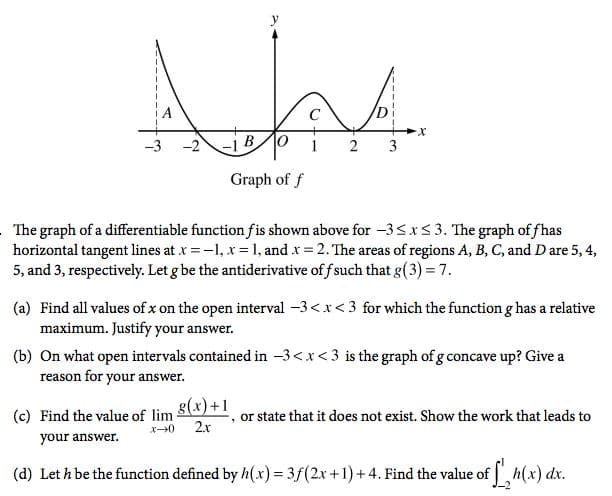A -3 3 Graph of f The graph of a differentiable function fis shown above for -3
Algebra & Trigonometry with Analytic Geometry
13th Edition
ISBN:9781133382119
Author:Swokowski
Publisher:Swokowski
Chapter3: Functions And Graphs
Section3.5: Graphs Of Functions
Problem 59E
Related questions
Question

Transcribed Image Text:C
-3
-2
-1 B0
1
2
3
Graph of f
The graph of a differentiable function fis shown above for -3<x5 3. The graph of fhas
horizontal tangent lines at x = -1, x =1, and x = 2. The areas of regions A, B, C, and D are 5, 4,
5, and 3, respectively. Let g be the antiderivative of f such that g(3) = 7.
(a) Find all values of x on the open interval -3<x< 3 for which the functiong has a relative
maximum. Justify your answer.
(b) On what open intervals contained in -3<x<3 is the graph of g concave up? Give a
reason for your answer.
g(x) +1
(c) Find the value of lim-
2.r
or state that it does not exist. Show the work that leads to
your answer.
(d) Let h be the function defined by h(x) = 3f(2x +1) +4. Find the value of h(x) dx.
Expert Solution
This question has been solved!
Explore an expertly crafted, step-by-step solution for a thorough understanding of key concepts.
This is a popular solution!
Trending now
This is a popular solution!
Step by step
Solved in 3 steps

Follow-up Questions
Read through expert solutions to related follow-up questions below.
Follow-up Question
But the area under a curve is not positive if it's below the x-axis. Area can be negative when it is under the x-axis. Area is routinely negative when we find the area under a cure using integrals. Why would you say that the area cannot be negative?
Solution
Follow-up Question
Why isn't region B -4 instead of positive 4?
Solution
Knowledge Booster
Learn more about
Need a deep-dive on the concept behind this application? Look no further. Learn more about this topic, advanced-math and related others by exploring similar questions and additional content below.Recommended textbooks for you

Algebra & Trigonometry with Analytic Geometry
Algebra
ISBN:
9781133382119
Author:
Swokowski
Publisher:
Cengage

Algebra & Trigonometry with Analytic Geometry
Algebra
ISBN:
9781133382119
Author:
Swokowski
Publisher:
Cengage